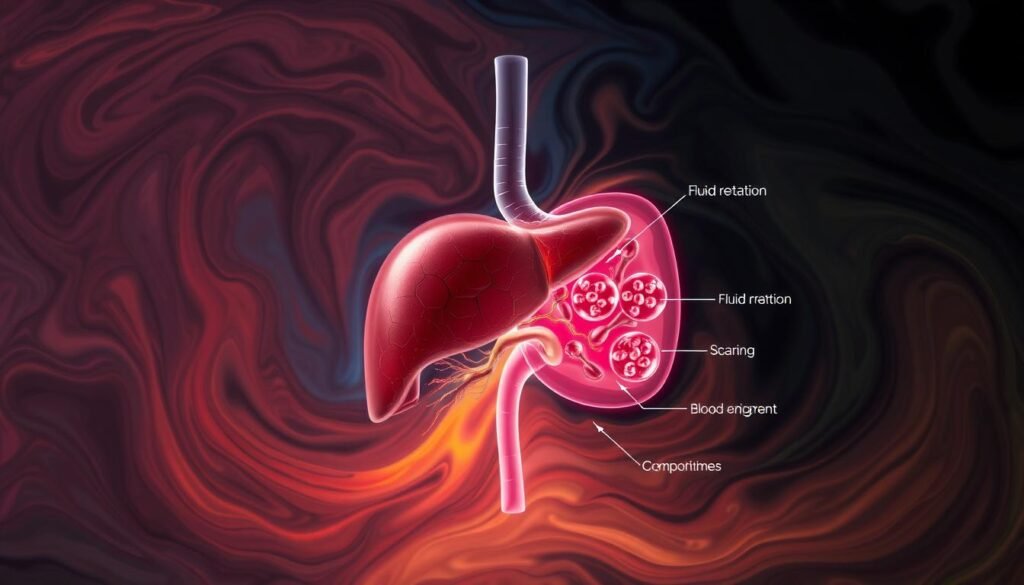About 2% of adults in the US have liver disease. This puts them at a higher risk for cirrhosis. Understanding this severe condition is vital. Cirrhosis means permanent scarring and damage to the liver. It poses big health challenges. It also makes people ask, is cirrhosis of the liver reversible?
The liver can usually heal itself, but cirrhosis means a lot of it is damaged. Despite this, new research shows ways we might reverse cirrhosis. This is true especially if the liver damage is from alcohol or drugs. This article talks about cirrhosis – its causes, symptoms, how it gets worse, and treatment possibilities.
Key Takeaways
- Approximately 2% of American adults have liver disease.
- Cirrhosis is often not curable but can be managed with appropriate liver treatment.
- Effective early interventions can significantly mitigate liver damage.
- Research continues to explore new therapies aimed at reversing liver damage.
- Recognizing symptoms early can lead to better management of liver disease.
- Alcohol and drug abuse are common contributing factors to the development of cirrhosis.
Understanding Cirrhosis of the Liver
Cirrhosis is a serious health issue marked by progressive scarring of the liver. This scarring damages liver functions. It usually results from long-term liver diseases like alcohol abuse, hepatitis, or fatty liver disease due to obesity. The condition is split into two phases: compensated and decompensated cirrhosis. In the compensated stage, the liver still works. But in the decompensated stage, it leads to severe health problems.
The liver can heal itself, but fibrosis makes this hard. Most of the time, cirrhosis can’t be reversed once it’s there. This highlights the need for early detection and action. Regular liver health checks can spot damage early, before cirrhosis gets worse.
It’s important to know the signs, such as tiredness, yellow skin, swollen stomach, and losing your appetite. Knowing these can help those at risk. The seriousness of liver cirrhosis is measured with tools like the Child-Pugh score. This score helps decide on the best treatment plan.
Getting care from experts, like those at Raleigh Medical Group Gastroenterology, can make a big difference. They offer treatments made just for you. Understanding cirrhosis well is key to better awareness and taking charge of your health.
What Causes Cirrhosis?
Cirrhosis is caused by many factors that lead to liver damage and scar tissue. Knowing the main causes is key to avoid more health problems. This issue can come from long-lasting hepatitis, metabolism issues, and using harmful substances. Drinking too much alcohol plays a big role in harming the liver.
Common Causes of Liver Damage
Liver damage, leading to cirrhosis, comes from various conditions. The most common ones include:
- Chronic viral hepatitis (types B and C)
- Long-term alcohol abuse
- Non-alcoholic fatty liver disease (NAFLD)
- Autoimmune hepatitis
- Genetic disorders such as hemochromatosis
All these conditions harm the liver in different ways. But, they can all lead to serious liver inflammation and disorder. This damage causes big changes in the liver, which can result in cirrhosis.
Effects of Alcohol and Drug Abuse on Liver Health
Alcohol is especially bad for the liver. Drinking too much for a long time can start harmful processes in the liver, including:
- Fatty liver (steatosis)
- Alcoholic hepatitis
- Fibrosis and cirrhosis
Using drugs can also hurt the liver by bringing harmful chemicals that damage liver cells. Together, drugs and alcohol greatly increase the risk of lasting liver damage. It’s very important to tackle these issues early on.
Signs and Symptoms of Liver Disease
Knowing the signs of liver damage is critical. Early symptoms are gradual but include fatigue, jaundice, and abdominal discomfort. Cognitive problems, such as poor memory and concentration, can also occur as liver function drops. This happens because toxins build up in the body. If you notice these signs, it’s vital to get checked by a doctor quickly.
Early Warning Signs of Liver Damage
Common early warning signs of liver damage include:
- Persistent fatigue
- Loss of appetite
- Nausea
- Easy bruising
These signs show the liver isn’t working well. It’s crucial to catch these early and seek medical help to tackle the issues head-on.
Fatigue and Cognitive Issues
Fatigue is a key early sign of liver problems. If the liver can’t clean the body properly, you feel very tired. Problems with thinking or remembering things may follow. This gets worse as more toxins stay in your blood. Getting a doctor’s help for these problems can prevent more serious liver issues.
How Does Liver Damage Progress to Cirrhosis?
Liver damage turning into cirrhosis is a complex process. It mainly involves chronic liver inflammation. This inflammation leads to the activation of hepatic stellate cells, crucial in liver damage’s advancement. These steps are key to grasp how liver issues develop and figure out the best treatments.
The Role of Hepatic Stellate Cells
Hepatic stellate cells are vital in creating liver fibrosis. Once active, they change into myofibroblasts. These myofibroblasts are in charge of making collagen and other extracellular matrix components. Their overactivity causes too much fibrous tissue, making fibrosis worse. Stopping these cells from getting activated is a goal in finding treatments for fibrosis.
Chronic Inflammation and Fibrogenesis
Chronic liver inflammation starts a chain reaction that increases fibrogenesis. This is due to inflammatory cytokines that wake hepatic stellate cells up. Elements like reactive oxygen species and various cytokines cause oxidative stress and more liver harm. This ongoing inflammation not only speeds up fibrosis but also raises the risk of serious complications. Treating this chronic inflammation is a must in care plans. For more info on how liver health impacts overall wellness, check out Mayo Clinic’s take on liver failure.
| Process | Description | Impact on Liver Health |
|---|---|---|
| Activation of Hepatic Stellate Cells | HSCs transform into myofibroblasts to produce collagen | Increases fibrosis, leading to cirrhosis |
| Chronic Inflammation | Persistent inflammation from various factors | Drives fibrogenesis, promotes liver damage |
| Oxidative Stress | Resulting from reactive oxygen species in the liver | Stimulates HSC activation and liver injury |
Grasping these disease mechanisms is key in finding treatments for cirrhosis-related conditions.
Is Cirrhosis of the Liver Reversible?
People’s understanding of reversing cirrhosis has changed a lot recently. In the past, cirrhosis was seen as something that couldn’t be undone. But now, studies show that some cirrhosis cases might actually get better with the right treatment. When patients receive care aimed at the root causes, their liver function can improve. However, getting the liver back to normal is complicated and depends on the individual.
Evidence of Reversibility in Liver Injury
New research tells us that liver fibrosis, which can lead to cirrhosis, might be reversible. If someone stops drinking alcohol or gets treatment for hepatitis, their liver can start to heal. Clinical trials have shown that getting medical care early and living a healthier lifestyle can really boost liver health. These changes have been proven through better imaging results and biopsy findings.
Factors That Influence Liver Regeneration
Liver healing depends on several things, like how old someone is, how healthy they generally are, and how bad their liver damage is. Making positive changes, like eating well, avoiding harmful substances, and getting regular check-ups, can help the liver repair itself. By choosing healthier habits, people can increase their chances of turning their liver health around.
| Factor | Importance for Liver Health |
|---|---|
| Age | Younger people are more likely to improve liver function than older adults. |
| Nutritional Status | Eating well supports liver healing and overall wellness. |
| Cessation of Harmful Substances | Stopping alcohol and other toxins is key for less liver damage. |
| Regular Monitoring | Getting health checks often catches liver changes early for quick action. |
Current Treatments for Cirrhosis
Treatment for cirrhosis aims to handle its root causes and offer support. Even though we can’t reverse it fully, we can stop more harm. Doing so improves life quality for the people it touches.
Managing Underlying Causes of Cirrhosis
It’s key to tackle what leads to cirrhosis for proper treatment. Staying away from alcohol, fighting any viral hepatitis, and keeping an eye out for complications are crucial. Certain meds can help with particular issues, while changing how you live can aid your liver.
- Avoid all alcohol consumption; no amount is safe for patients with cirrhosis.
- Regular check-ups to screen for liver cancer, including ultrasound scans and blood tests every six months.
- Management of type 2 diabetes, taking care to balance medications and monitor blood sugar levels regularly.
- Treatment for complications like encephalopathy with medications, such as lactulose syrup and rifaximin.
General Lifestyle Changes and Dietary Recommendations
Changing your lifestyle is key to managing liver disease well. A diet made for people with cirrhosis can greatly impact their health.

| Nutrient | Recommendations |
|---|---|
| Protein | Lean sources such as chicken, fish, and legumes are recommended. |
| Sodium | Restrict intake to less than 2 grams to help manage fluid retention. |
| Fruits and Vegetables | Incorporate a variety for essential vitamins and minerals. |
| Hydration | Stay well-hydrated, but fluid intake may be limited based on individual needs. |
| Supplements | Avoid herbal supplements unless recommended by a healthcare provider. |
Regular exercise goes well with dietary advice, helping your liver stay healthy. Keeping a healthy weight is good, especially if you have type 2 diabetes. By following these tips, you can manage liver disease better and improve your well-being.
Advanced Treatments for Liver Disease
When cirrhosis reaches a late stage, a range of treatment options become crucial. Patients with serious complications might need stronger treatments. This can include drugs for liver health and even liver transplantation. The goal of these treatments is to bring hope and better life quality to those facing severe liver problems.
Medications for Liver Health
There are many medications important for controlling cirrhosis symptoms. The most common treatments include:
- Antiviral medications for managing hepatitis, effectively reducing viral load and promoting liver health.
- Corticosteroids prescribed for autoimmune liver diseases, helping to stabilize liver function.
- Other therapeutic agents targeting specific symptoms, which aid in enhancing overall health and quality of life.
These drugs are pivotal in maintaining liver function. In certain cases, they can even help in recovery. This highlights the crucial role of good pharmacological management.
Liver Transplantation as a Last Resort
If cirrhosis causes irreversible liver damage or extreme complications, liver transplantation might be necessary. This surgery replaces the damaged liver with a healthy one from a donor. Important points include:
- The availability of living donor liver transplantation, which offers an alternative path for many patients in need.
- Liver transplantation is considered the definitive treatment for patients experiencing life-threatening liver failure.
- The MELD score (Model for End-Stage Liver Disease) helps prioritize transplant candidates based on their liver function and overall prognosis.
Liver transplantation involves thorough assessments and matching processes. Yet, it gives many with severe liver disease a new chance at life.
| Treatment Type | Description | Indications |
|---|---|---|
| Medications for Liver Health | Pharmaceuticals that manage symptoms, improve liver function, and aid recovery. | Advanced cirrhosis with complications |
| Liver Transplantation | Replacement of the failing liver with a healthy donor organ. | End-stage liver disease and irreversible damage |
Managing Complications from Cirrhosis
Cirrhosis can lead to severe complications. Proper management is key to enhance quality of life. Addressing these complications is essential for better health outcomes.
Common Complications of Cirrhosis
Portal hypertension is a major issue caused by cirrhosis. It increases pressure in the portal vein. This condition can cause:
- Ascites: Swelling and fluid buildup in the abdomen
- Hepatic encephalopathy: Decline in brain function
- Liver cancer
- Variceal bleeding: Dangerous bleeding from swollen veins
Each complication requires specific treatments. Regular doctor visits and interventions are necessary.
Importance of Monitoring Liver Function
Regular liver function monitoring is crucial for cirrhosis patients. It involves blood tests and advanced imaging. Detecting issues early leads to better treatment results.
By catching problems early, doctors can better manage the disease. Regular checks improve everything from treatment to survival rates.
Tests like abdominal angiography and biopsies are important. They help manage cirrhosis complications effectively, along with other tests such as elastography and lab tests.
| Test Type | Description |
|---|---|
| Abdominal Angiography | Imaging to visualize blood vessels and check for blockages |
| Biopsy | Sample collection for detailed examination of liver tissue |
| Elastography | Non-invasive test to measure liver stiffness |
| Lab Tests | Blood tests to check liver function and potential infections |
By staying alert to changes in liver function, patients can better manage their health. Support from specialists in various fields is crucial. This ensures a comprehensive treatment approach, detailed further in treatment strategies for cirrhosis.

Future Directions in Cirrhosis Treatment
Research into liver diseases is moving forward quickly. We are seeing exciting new possibilities for the future. A focus on new treatments aims to change how we manage cirrhosis, especially through antifibrotic treatments.
Scientists are learning more about how liver fibrosis works. They are finding different ways to fight this worsening condition.
Research and Developments in Antifibrotic Therapies
There has been great progress in creating antifibrotic agents. These agents work by stopping the activation of hepatic stellate cells, which play a big part in fibrosis. Clinical trials are now looking into how effective these new treatments are for serious liver damage.
By focusing on the main causes of cirrhosis, these drugs could slow down the disease. They might even help the liver to heal.
Potential New Treatments on the Horizon
Exciting new treatments like gene therapies and stem cell uses are being studied. They aim to undo fibrosis and make the liver work right again. As research continues, people might get to choose from more treatment options that fit their needs.
For more information on these new treatments, read this detailed article.
Patient Perspectives and Support
Understanding patient experiences is key to developing effective treatment plans for those with liver disease. Having a support system helps people deal with cirrhosis challenges. Joining cirrhosis support groups offers emotional and practical help for managing the disease.
People gain comfort from sharing their experiences in these groups. They learn from each other’s struggles and how they cope. This kind of support can help improve mental health. It makes dealing with treatment and necessary lifestyle changes easier.
Support groups also talk about ways to deal with the disease and useful resources. They can connect patients with experts in liver disease support. This helps patients better understand and handle their condition.
Peer support plays a vital role. It often makes people feel less alone. Hearing others’ stories helps create a sense of community and support among group members.

| Type of Support | Description | Benefits |
|---|---|---|
| Peer Support | Connections with others facing similar struggles. | Reduced feelings of isolation and shared coping strategies. |
| Emotional Support | Counseling services and support groups. | Improved mental well-being and morale. |
| Informational Support | Access to resources and experienced healthcare providers. | Informed decision-making and better disease management. |
Being involved with liver disease support can greatly enhance quality of life for those with cirrhosis. Education, emotional support, and social ties often lead to greater resilience. It makes navigating liver disease more bearable.
Conclusion
Cirrhosis of the liver is tough but there’s hope on the horizon. Knowing early on and taking action makes a big difference. It improves liver health and life overall. People with cirrhosis have many treatment options that meet their unique needs.
Even though cirrhosis can’t be reversed, lifestyle changes and treatment can help the liver heal itself. With ongoing research, there’s hope for even better treatments and liver transplants. Patients and doctors need to work closely together. They must keep an eye on liver health and stay up-to-date with new treatments.
The focus is still on preventing cirrhosis, especially by avoiding too much alcohol and viral hepatitis. If we take care of our liver, we can avoid this disease. For those living with cirrhosis, a positive approach and current treatments offer a way to handle their condition confidently.